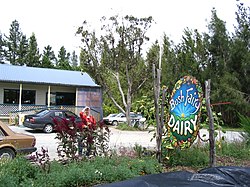Peria, Northland
Peria | |
|---|---|
 The Bush Fairy Dairy at Peria | |
 | |
| Coordinates: 35°5′54″S 173°29′17″E / 35.09833°S 173.48806°E | |
| Country | New Zealand |
| Region | Northland Region |
| District | Far North District |
| Ward | Te Hiku |
| Electorates | |
| Government | |
| • Territorial Authority | Far North District Council |
| • Regional council | Northland Regional Council |
Peria is a locality in Northland, New Zealand. It lies south of Taipa and east of Kaitaia. The area was once known as Oruru Valley.[1]
Wiremu Hoani Taua, who later became the first Maori person to be appointed as the head teacher of a native school, served on the Peria Native School Committee until 1900.[2]
Demographics
[edit]The Peria statistical area covers 199.63 km2 (77.08 sq mi)[3] and had an estimated population of 1,280 as of June 2023,[4] with a population density of 6.4 people per km2.
| Year | Pop. | ±% p.a. |
|---|---|---|
| 2006 | 1,011 | — |
| 2013 | 951 | −0.87% |
| 2018 | 1,107 | +3.08% |
| Source: [5] | ||
Peria had a population of 1,107 at the 2018 New Zealand census, an increase of 156 people (16.4%) since the 2013 census, and an increase of 96 people (9.5%) since the 2006 census. There were 423 households, comprising 585 males and 522 females, giving a sex ratio of 1.12 males per female. The median age was 46.4 years (compared with 37.4 years nationally), with 228 people (20.6%) aged under 15 years, 159 (14.4%) aged 15 to 29, 540 (48.8%) aged 30 to 64, and 177 (16.0%) aged 65 or older.
Ethnicities were 74.3% European/Pākehā, 40.1% Māori, 3.0% Pacific peoples, 2.7% Asian, and 2.7% other ethnicities. People may identify with more than one ethnicity.
The percentage of people born overseas was 14.4, compared with 27.1% nationally.
Of those people who chose to answer the census's question about religious affiliation, 52.3% had no religion, 30.4% were Christian, 4.3% had Māori religious beliefs, 0.5% were Muslim, 1.4% were Buddhist and 2.4% had other religions.
Of those at least 15 years old, 108 (12.3%) people had a bachelor's or higher degree, and 183 (20.8%) people had no formal qualifications. The median income was $19,600, compared with $31,800 nationally. 45 people (5.1%) earned over $70,000 compared to 17.2% nationally. The employment status of those at least 15 was that 324 (36.9%) people were employed full-time, 126 (14.3%) were part-time, and 60 (6.8%) were unemployed.[5]
Education
[edit]Peria School is a coeducational full primary (years 1-8) school[6] with a roll of 72 students as of February 2024.[7] The school was established in 1873, It was a native school until 1914.[8]
The local marae, Te Kauhanga, and its meeting house, Te Poho o Ngāti Kahu, are a tribal meeting place for the Ngāti Kahu hapū of Te Paatu ki Pēria.[9][10]
Notes
[edit]- ^ "Peria Valley". Archived from the original on 4 July 2007. Retrieved 23 January 2008.
- ^ "Taua, Wiremu Hoani". Dictionary of New Zealand Biography.
- ^ "ArcGIS Web Application". statsnz.maps.arcgis.com. Retrieved 25 December 2023.
- ^ "Population estimate tables - NZ.Stat". Statistics New Zealand. Retrieved 25 October 2023.
- ^ a b "Statistical area 1 dataset for 2018 Census". Statistics New Zealand. March 2020. Peria (101300). 2018 Census place summary: Peria
- ^ Education Counts: Peria School
- ^ "New Zealand Schools Directory". New Zealand Ministry of Education. Retrieved 14 March 2024.
- ^ "School records [Peria Public School]". Te Ahu Heritage Museum. Retrieved 1 April 2022.
- ^ "Te Kāhui Māngai directory". tkm.govt.nz. Te Puni Kōkiri.
- ^ "Māori Maps". maorimaps.com. Te Potiki National Trust.